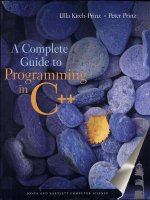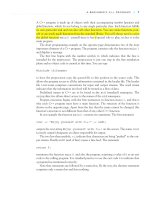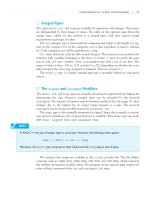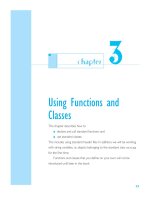A Complete Guide to Programming in C++ part 42 doc
Bạn đang xem bản rút gọn của tài liệu. Xem và tải ngay bản đầy đủ của tài liệu tại đây (188.62 KB, 10 trang )
CLOSING FILES
■
389
ᮀ Motivation
After you have completed file manipulation, the file should always be closed for the fol-
lowing reasons:
■ data may be lost, if for some reason the program is not terminated correctly
■ there is a limit to the number of files that a program can open simultaneously.
A program that terminates correctly will automatically close any open files before exit-
ing. A file stream destructor will also close a file referenced by a stream. However, if the
file is no longer in use before this point, you should close the file explicitly.
ᮀ Methods close() and is_open()
Each of the file stream classes contains a definition of a void type method called
close(), which is used to close the file belonging to the stream.
Example: myfile.close();
However, the file stream continues to exist. It is therefore possible to use the stream
to open and manipulate another file.
If you are not sure whether a file stream is currently accessing a file, you can always
perform a test using the is_open() method . In the case of the myfile file stream, the
test is as follows:
Example: if( myfile.is_open() )
{ /* . . . */ } // File is open
ᮀ The exit() Function
Open files are also closed when you call the global function exit(). The actual reason
for using this function is to terminate a program in an orderly manner and return an error
code to the calling process.
Prototype: void exit( int status );
The calling process, to which the status error code is passed for evaluation, will
often be the command interpreter—a Unix shell, for example. Successful program execu-
tion normally produces the error code 0. The statement return n; is thus equivalent
to the statement exit(n); when used in the main() function.
The program on the opposite page copies a file stated in the command line. If the user
forgets to state a second (target) file, the source file is copied to standard output. In this
case, the source file will need to be a text file.
390
■
CHAPTER 18 FUNDAMENTALS OF FILE INPUT AND OUTPUT
// Pizza_W.cpp
// Demonstrating output of records block by block.
//
#include <iostream>
#include <fstream>
using namespace std;
char header[] =
" * * * P I Z Z A P R O N T O * * *\n\n";
// Record structure:
struct Pizza { char name[32]; float price; };
const int MAXCNT = 10;
Pizza pizzaMenu[MAXCNT] =
{
{ "Pepperoni", 9.90F }, { "White Pizza", 15.90F },
{ "Ham Pizza", 12.50F }, { "Calzone", 14.90F } };
int cnt = 4;
char pizzaFile[256] = "pizza.fle";
int main() // To write records.
{
cout << header << endl;
// To write data into the file:
int exitCode = 0;
ofstream outFile( pizzaFile, ios::out|ios::binary );
if( !outFile)
{
cerr << "Error opening the file!" << endl;
exitCode = 1;
}
else
{
for( int i = 0; i < cnt; ++i)
if( !outFile.write( (char*)&pizzaMenu[i],
sizeof(Pizza)) )
{ cerr << "Error writing!" << endl;
exitCode = 2;
}
}
if( exitCode == 0)
cout << "\nData has been added to file "
<< pizzaFile << "\n" << endl;
return exitCode;
}
■
READING AND WRITING BLOCKS
Sample program
READING AND WRITING BLOCKS
■
391
The file stream classes can use all the public operations defined in their base classes.
This means you can write formatted or unformatted data to a file or read that data from
the file block by block or character by character.
ᮀ Formatted and Unformatted Input and Output
The previous sample programs illustrated how to use the methods get(), getline(),
and put() to read or write data from or to text files. Formatted input and output of
numerical values, for example, requires the >> and << operators and appropriate manip-
ulators or formatting methods.
Example: double price = 12.34;
ofstream textFile("Test.txt");
textFile << "Price: " << price << "Dollar" << endl;
The file Test.txt will contain a line of text, such as "Price " that exactly
matches the screen output.
Converting binary data to legible text is not practicable if you are dealing with large
amounts of data. It makes sense to write the data for a series of measurements to a binary
file in the order in which they occur in the program. To do so, you simply open the file
in binary mode and write the data to the file, or read it from the file, block by block.
ᮀ Transferring Data Blocks
The ostream method write() transfers given number of bytes from main memory to a
file.
Prototype: ostream& write( const char *buf, int n);
Since write() returns a reference to the stream, you can check to ensure that the write
operation was successful.
Example: if( ! fileStream.write("An example ", 2) )
cerr << "Error in writing!" << endl;
A warning is issued if an error occurs while writing the characters "An". You can use the
read() method to read data blocks from the file. The method transfers a data block
from a file to a program buffer.
Prototype: istream& read( char *buf, int n);
The methods read() and write() are often used for files with fixed length records.
The block that needs to be transferred can contain one or more records. The buffer in
main memory is either a structure variable or an array with elements belonging to the
structure type. You need to cast the address of this memory area to (char *) as shown
in the example opposite.
392
■
CHAPTER 18 FUNDAMENTALS OF FILE INPUT AND OUTPUT
// Class Account with methods read() and write()
//
class Account
{
private:
string name; // Account holder
unsigned long nr; // Account number
double balance; // Balance of account
public:
. . . // Constructors, destructor,
// access methods,
ostream& Account::write(ostream& os) const;
istream& Account::read(istream& is)
};
// write() outputs an account into the given stream os.
// Returns: The given stream.
ostream& Account::write(ostream& os) const
{
os << name << '\0'; // To write a string
os.write((char*)&nr, sizeof(nr) );
os.write((char*)&balance, sizeof(balance) );
return os;
}
// read() is the opposite function of write().
// read() inputs an account from the stream is
// and writes it into the members of the current object
istream& Account::read(istream& is)
{
getline( is, name, '\0'); // Read a string
is.read( (char*)&nr, sizeof(nr) );
is.read( (char*)&balance, sizeof(balance));
return is;
}
■
OBJECT PERSISTENCE
Class Account
Implementing methods
read() and write()
OBJECT PERSISTENCE
■
393
ᮀ Storing Objects
Objects are created during program runtime and cleaned up before the program termi-
nates. To avoid this volatility, you can make an object persistent, that is, you can store
the object in a file. However, you must ensure that the object can be reconstructed, as it
was, when read. This means dealing with the following issues:
■ Objects can contain other objects. You will generally not know how to store a
member object.
■ Objects can contain references to other objects. However, it does not make sense
to store pointer values in a file, as the memory addresses will change each time
you re-launch the program.
For example, the class Account on the opposite page contains the member object
name, which is a string type. As string type objects are used to handle variable
length strings, the object just contains a reference to the string. It therefore makes no
sense to save the memory content of size sizeof(name) occupied by the object name
in a file. Instead, you should write the string itself to a file.
One possible solution to this issue is to store the data to allow them to be passed to a
constructor for the class when read. Another solution involves providing methods to
allow the objects to write their own data members to files or read them from files. This
technique is normally preferable since the class can now handle data storage itself, allow-
ing it to write internal status data while simultaneously preventing external access to
that data.
ᮀ Storing Account Class Objects
The opposite page shows the Account class, with which you are already familiar. File
input and output methods have been added to the class. A file stream that references a
file opened in binary mode is passed as an argument to the methods read() and
write(). The return value is the stream in both cases, so the status can be queried
when the function is called.
Example: if( ! anAccount.write( outFile) )
cerr << "Error in writing!" << endl;
When you read an account, you can simultaneously create an empty object that the
read() method can access.
Example: if( ! anAccount.read( inFile) )
cerr << "Error in reading!" << endl;
The member object name is saved as a C string, that is, as a string terminated by the null
character, '\0'. The << operator and the function getline() are available for this
task.
exercises
394
■
CHAPTER 18 FUNDAMENTALS OF FILE INPUT AND OUTPUT
fcopy file1 file2
A file, file1, is copied to file2. If file2 already exists, it is overwritten.
fcopy file1
A file, file1, is copied to standard output, that is, to the screen if
standard output has not been redirected.
fcopy
For calls without arguments, the source and destination files are entered
in a user dialog.
If is is a file stream that references a file opened for reading, the
following call
Example:
char buf[1024];
is.read(buf, 1024);
transfers the next 1024 bytes from file to the buffer buf. Provided that no
error occurs, no less than 1024 bytes will be copied unless end-of-file is
reached. In this case the
fail and eof bits are set.The last block of bytes
to be read also has to be written to the destination file.The method
gcount() returns the number of bytes transferred by the last read
operation.
Example:
int nread = is.gcount(); // Number of bytes
// in last read op.
■
EXERCISES
For exercise 1
Possible calls to the program fcopy:
More details on the istream class method
read()
EXERCISES
■
395
Exercise 1
The sample program fcopy1, which copies a file to the screen or to a second
file, was introduced in this chapter.Write a program named
fcopy to enhance
fcopy1 as follows:
■ If the program is launched without any arguments, it does not issue an
error message and terminate but requests user input for the names of the
source and target files. If an empty string is given as the name of the tar-
get file, that is, the Return key is pressed, the source file is displayed on
screen.
■ If the command line or the user dialog contains valid source and target
file names, a binary copy operation is performed.
■ Copy the data block by block with the read() and write() methods.
The default block size is 1024 bytes.
■ The copy() function returns false if an error occurs while copying and
true in all other cases.
Also refer to the notes on the opposite page.
Exercise 2
a. Modify the sample program Pizza_w.cpp in this chapter to allow the
user to add new pizza records to the four standard pizzas and store
these records on file.
b. Then write a program called
Pizza_r.cpp, which displays the pizza
menu, that is, outputs the contents of the pizza file.
Exercise 3
Test the methods read() and write() in the Account class.To do so, write a
program called
Account_rw.cpp that
■ initializes an array with account objects and stores the array in a file
■ reads the contents of the file to a second array and displays the accounts
in that array to allow you to check them.
Use binary mode for read or write access to the file.
396
■
CHAPTER 18 FUNDAMENTALS OF FILE INPUT AND OUTPUT
New data members:
string filename; // File name
bool dirty; // true, if data is not
// stored yet.
New methods:
const string& getFilename() const;
bool setFilename( const string& fn);
bool isDirty() const;
bool load(); // Read data from the file
bool save(); // Save data.
bool saveAs(); // Save data as
* * * * * Telephone List * * * * *
S = Show all entries
F = Find a telephone number
A = Append an entry
D = Delete an entry
O = Open a file
W = Save in the file
U = Save as
Q = Quit the program
Your choice:
For Exercise 4
New members of class TelList
Extended menu of the application program
EXERCISES
■
397
Exercise 4
The program TelList, which was written as an exercise for Chapter 16, needs
to be modified to allow telephone lists to be saved in a file.
To allow this, first add the data members and methods detailed on the
opposite page to
TelList.The string filename is used to store the name of
the file in use.The dirty flag is raised to indicate that the phone list has been
changed but not saved.You will need to modify the existing methods
append()
and erase()to provide this functionality.
The strings in the phone list must be saved as C strings in a binary file,
allowing for entries that contain several lines.
Add the following items to the application program menu:
O = Open a file
Read a phone list previously stored in a file.
W = Save
Save the current phone list in a file.
U = Save as . . .
Save the current phone list in a new file.
Choosing one of these menu items calls one of the following methods as
applicable:
load(), save() or saveAs().These methods return true for a
successful action and
false otherwise.The user must be able to supply a file
name for the
save() method, as the list may not have been read from a file
previously.
If the phone list has been modified but not saved, the user should be
prompted to save the current phone list before opening another file or
terminating the program.
solutions
398
■
CHAPTER 18 FUNDAMENTALS OF FILE INPUT AND OUTPUT
■
SOLUTIONS
Exercise 1
//
// fcopy.cpp
// Copy files
// Call: fcopy [ source [ destination ] ]
//
#include <iostream>
#include <fstream>
using namespace std;
char usage[] = "Call: fcopy [source [destination]}";
inline void openerror( const char *file)
{
cerr << "Error opening the file " << file << endl;
exit(1);
}
bool copy( istream& is, ostream& os), // Prototype,
ok = true; // ok flag.
int main(int argc, char *argv[])
{
char source[256] = "", dest[256] = "";
switch( argc )
{
case 1: // No file declared
// ==> input file name.
cout << "Copying source file to "
"destination file!\n"
"Source file: ";
cin.getline( source, 256);
if( strlen(source) == 0)
{ cerr << "No source file declared!" << endl;
return 1;
}
cin.sync(); // No previous input
cout << "Destination file: ";
cin.getline( dest, 256);
break;
case 2: // One file is declared.
strcpy( source, argv[1]);
break;
case 3: // Source and destination files are declared.
strcpy( source, argv[1]);
strcpy( dest, argv[2]);
break;









